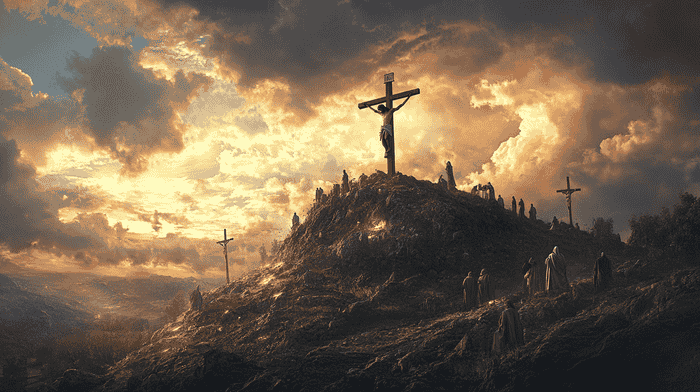What Happened That Day?
Crucifixion wasn’t special. The Romans did it constantly. It was their way of making an example out of people. Public, brutal, humiliating. When Jesus was crucified, he wasn’t the only one. In fact, we’re told in all four gospels that he was killed alongside two others.
“Then two robbers were crucified with him, one on the right and one on the left.” -Matthew 27:38 NKJV
Three crosses, three condemned men. But even in that crowd of the condemned, Jesus’ case stands out.
Pilate, the Roman governor who gave the final order, said he found no fault in him.
“I find no fault in Him at all.” Pilate said more than once - John 18:38 NKJV
And yet, under pressure from the crowd, he handed Jesus over to be executed.
What followed is familiar, but still hard to sit with. Jesus is beaten, mocked, dressed in a purple robe, and a crown of thorns. The soldiers kneel in fake worship, laughing. Then they strip him again and drag him to Golgotha (“the place of the skull”).
And then comes the part we’re almost too used to hearing. “There they crucified him” (John 19:18). The gospels are oddly restrained about the physical agony. Maybe because they knew their audience had seen it before.
But what they do focus on is the words. Jesus, even while dying, speaks. And what he says matters. He asks God to forgive the people killing him:
“Father, forgive them, for they do not know what they do.” Luke 23:3 NKJV
He tells one of the men dying beside him, “Assuredly, I say to you, today you will be with Me in Paradise” (Luke 23:43 NKJV). And finally, before breathing his last, he says, “It is finished” (John 19:30 NKJV).
Those words suggest that something was completed that day, something bigger than the execution itself. This wasn’t just another act of Roman cruelty. And Jesus wasn’t just another victim of the empire.
What It Meant Then: A Scandal, A Statement, A Sacrifice
For the people who followed Jesus, the crucifixion was confusing. He was supposed to be the Messiah. The one who would restore Israel, overthrow oppression, maybe even change everything. And yet there he was, executed like a criminal.
The Messiah wasn’t supposed to die. Deuteronomy 21:23 NKJV even says, “He who is hanged is accursed of God.” That verse alone was enough to make early Christians uncomfortable. How could the chosen one of God be cursed?
That’s why the cross, at first, was a scandal. Paul says it outright:
“But we preach Christ crucified, to the Jews a stumbling block and to the Greeks foolishness.” (1 Corinthians 1:23 NKJV).
In other words, it made no sense. It offended both religious and secular expectations. God doesn’t lose. God doesn’t die.
But slowly, the story changed.
Somehow, they began to see the crucifixion not as a failure, but as the plan. Jesus had said things that started to click in hindsight. He’d talked about laying down his life willingly (John 10:17-18).
He’d spoken of being “lifted up” like the bronze serpent in the wilderness (John 3:14), a strange image, but one that pointed to healing through suffering.
The cross, they came to believe, wasn’t just an act of violence. It was a sacrifice.
“For Christ also suffered once for sins, the just for the unjust, that He might bring us to God...” (1 Peter 3:18 NKJV)
Jesus wasn’t just dying because of our sins. He was dying for them.
It’s hard to wrap your head around it. That the place of death became the place of healing. That the worst thing became the thing that set people free.
But that’s what they believed. And for many, still do.
 Jesus walking with the cross on Via Dolorosa (image generated with Midjourney)
Jesus walking with the cross on Via Dolorosa (image generated with Midjourney)
Get Closer to God Today
4.9
Average Rating
|Over 5 Million Downloads
The Cross as a Mirror: What It Says About Us
The story of the crucifixion tells us something about people, about us. Because if you strip it down, the cross is what happens when love shows up and the world doesn’t know what to do with it.
The crowd that once cheered for Jesus turned on him. The leaders who claimed to protect the truth couldn’t handle what he was saying. The empire saw a threat and eliminated it.
The cross holds up a mirror to the parts of us we’d rather not see: the fear, the pride, the instinct to protect ourselves even if someone else pays the price. It reminds us that injustice isn’t always loud or obvious. Sometimes it looks like silence. Like Pilate, washing his hands.
And yet… Jesus doesn’t strike back. The cross doesn’t just reveal who we are. It reveals who God is if you believe Jesus is who he said he was.
It’s not the image of a distant, indifferent deity. It’s a God who shows up in weakness. Who doesn’t avoid pain, but enters it. Who doesn’t just tell us to forgive, but does it in real time, with nails in his hands.
There’s a kind of honesty in the crucifixion that’s hard to find anywhere else. It doesn’t pretend we’re better than we are. It just says: Even so, you’re loved.
Why Christians Call This ‘Good’ Friday
It’s a strange name, isn’t it? Good Friday. Nothing about the story sounds good at first. The earliest Christians didn’t soften the horror of it. They called it what it was: unjust, violent, humiliating. And still, they insisted it was good.
Colossians 2:14–15 NKJV puts it this way:
“Having wiped out the handwriting of requirements... having nailed it to the cross. Having disarmed principalities and powers...”
It’s a reversal. The very thing meant to shame him (the cross) becomes the thing that exposes everything else. That’s why Christians call it Good. Not because the day itself was pleasant. But because something was healed in that moment.
The Cross Today: Still Offensive, Still Liberating
The cross still makes people uncomfortable. It confronts you. Not with rules, but with a story. A man dying publicly, painfully, and forgiving the people doing it.
Because if the cross means anything, it means something’s wrong. That there’s a weight to human failure, and that it costs something to put it right. It says sin is real. That we’re not as fine as we pretend to be. And that someone else had to step in.
But if you can sit with that discomfort, there’s something freeing on the other side of it.
Because the cross also says you’re not alone. You’re not too far gone. You’re not stuck carrying every bad decision and every wound forever.
“For the message of the cross is foolishness to those who are perishing, but to us who are being saved it is the power of God.” (1 Corinthians 1:18 NKJV).
That’s what it comes down to. For some, it sounds like nonsense. For others, it’s the moment everything starts to make sense.
People still find freedom there. In prisons. In hospital rooms. In rehab. In church pews. In living rooms. Not because they figured everything out, but because they met grace in a place they didn’t expect it.
The cross doesn’t ask you to be perfect. It just asks you to stop pretending you are.
And sometimes, that’s the most liberating thing of all.
 A modern crucifix in a church (image generated with Midjourney)
A modern crucifix in a church (image generated with Midjourney)
Get Closer to God Today
4.9
Average Rating
|Over 5 Million Downloads
Final Thoughts
The story of Jesus on the cross isn’t simple. At its core, the cross shows us something we rarely want to admit: that we’re broken, but not abandoned.
We’ve looked at what happened that day, how it was understood back then, and why it still gets under people’s skin now. It keeps showing up in questions, in crises, in the quiet moments when life feels heavier than it should.
If any of this stirred something in you (a question, a feeling, a need to dig deeper), the Bible Chat App is a good place to start. It’s built to help you explore these harder questions in your own time, at your own pace, without judgment. Whether you’re new to all this or you’ve been in it for years, there’s space for you to wrestle, reflect, and maybe hear something that speaks right to where you are.
The cross won’t give you tidy answers. But if you stay with it, it just might give you something better.
References
- Bauckham, Richard. Jesus: A Very Short Introduction. Oxford: Oxford University Press, 2011.
- Brown, Raymond E. The Death of the Messiah: From Gethsemane to the Grave. New York: Doubleday, 1994.
- Wright, N. T. The Day the Revolution Began: Reconsidering the Meaning of Jesus’s Crucifixion. New York: HarperOne, 2016.
- Hengel, Martin. Crucifixion in the Ancient World and the Folly of the Message of the Cross. Philadelphia: Fortress Press, 1977.










